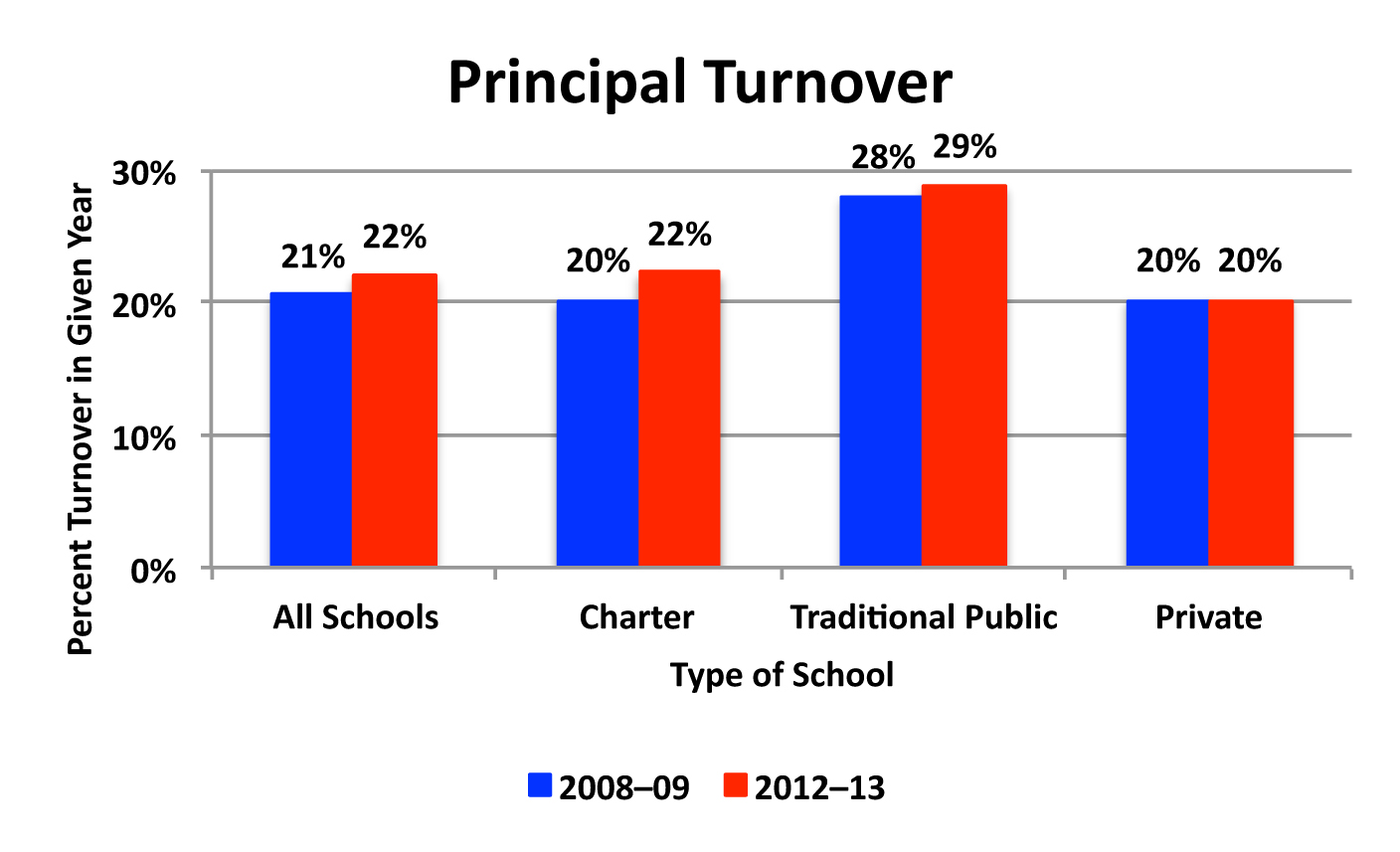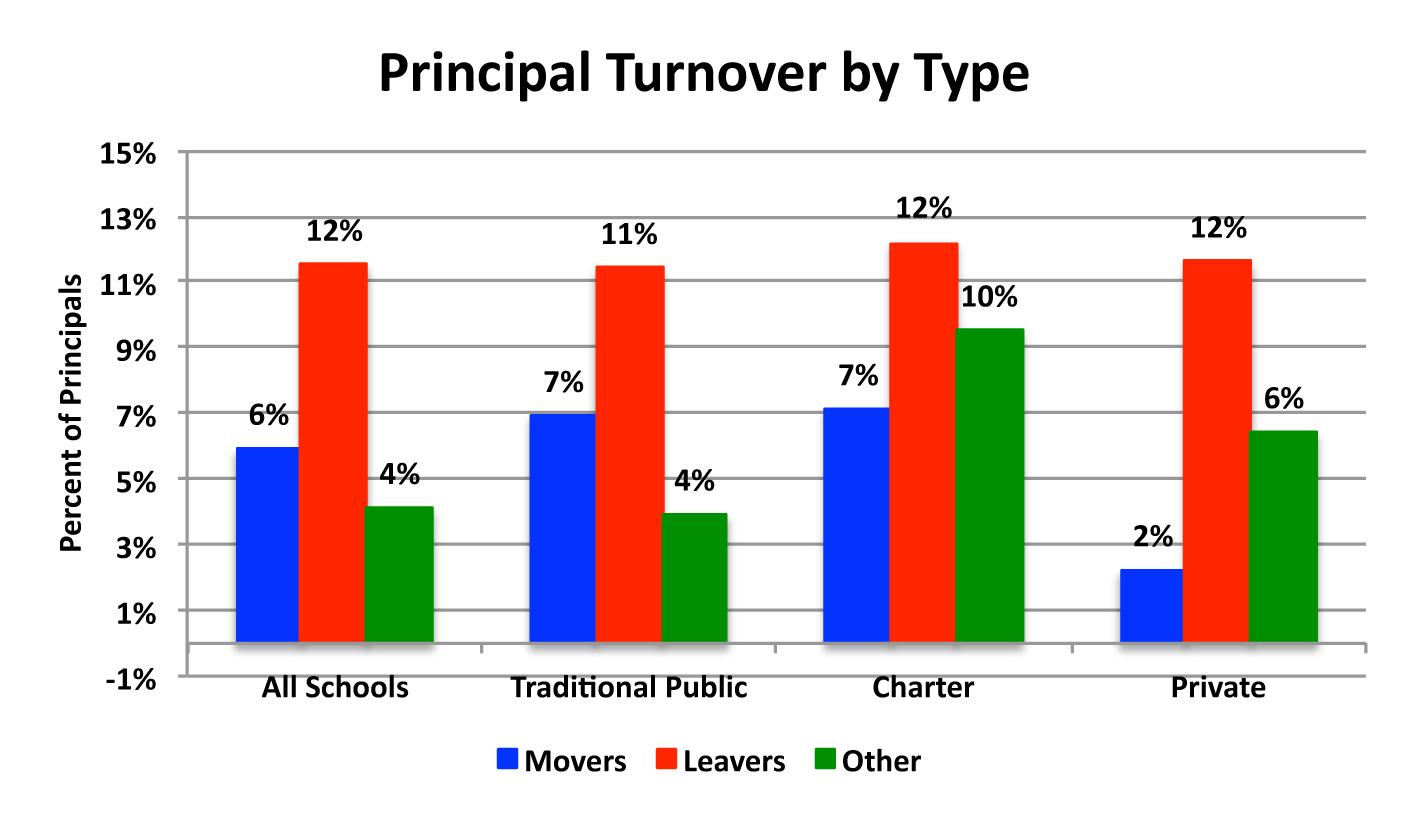What is the turnover rate for school principals?
Why is this question important? School principals are the second most important school-related factor, after teachers, in influencing student performance, accounting for about a quarter of total school effects (Marzano, Waters, & McNulty, 2005). There is increasingly clear evidence as to which practices of principals are associated with teaching effectiveness, student achievement, and high-performing schools (Robinson, Lloyd, & Rowe, 2008). Research suggests that the turnover rate of principals can have a significant impact on the quality of school performance. It can lead to greater teacher turnover (Béteille, Kalogrides, & Loeb, 2012), have a direct negative effect on student and school achievement (Burkhauser, Gates, Hamilton, & Ikemoto, 2012), and prevent large-scale change efforts that require approximately 5 years of leadership continuity (Seashore Louis, Leithwood, Wahlstrom, & Anderson, 2010). It is important to track principal turnover data to identify trends, see where turnover is the greatest, and provide a baseline metric for change efforts.
See further discussion below.


Movers: Principals who moved to a different school in the next school year
Leavers: Principals who left the profession
Other: Principals who left their current schools, but where they went is unknown
Results: The data give an account of attrition and mobility for principals who were employed the previous school year. For example, 2012–13 attrition and mobility data are for school principals employed in the 2011–12 school year, and the 2008–09 data for principals in the 2007–08 school year.
Of the 114,330 school principals in the United States during the 2011–12 school year, 25,153 (representing 22% of all school principals) left their positions the following year. Of these, at least 6,745 moved to another school (5.9%), and at least 13,148 left the profession (11.5%). There were no data on the remaining principals who did not return (4.6%). Those data show a slight increase in turnover from similar data collected in the 2008–09 school year, but the difference is not significant.
The percentage of school principals who stayed on the job at the same school remained stable over the 5-year period studied: 79.5% in 2008–09, and 78% in 2012–13.
Of all of the classifications of schools, charter schools had the highest turnover rates. In 2012–13, their turnover rate was 28.8%, versus 22.2% for public schools and 20.2% for private schools. Charter schools had a 6.6% higher turnover rate than public schools, and 8.6% higher than private schools.
A more exhaustive analysis of "leavers" and "movers" is handicapped by the relatively high percentage of principals who left their current schools but for whom further information is unavailable.
Implications: Given the critical role of principals in a school's success, turnover is a significant problem. The fact that one in five schools lost its principal in the 2008–09 and 2012–13 school years—and that the situation has not changed over the 5-year period studied—suggests that the system is not successful in recruiting, training, and supporting school principals.
The data also highlight the need for new principals to come into the system. At least 13,160 positions were vacated by principals leaving the profession, and there are as many as 3,280 additional openings, depending on where those in the "other" category went.
Study Description: The 2012–13 Principal Follow-up Survey (PFS) is a component of the Schools and Staffing Survey (SASS), a nationally representative sample survey of public and private K–12 schools, principals, and teachers in the 50 states and District of Columbia. The purpose of the SASS is to collect information that can provide a detailed picture of U.S. elementary and secondary schools and their staff. It was developed by the National Center for Education Statistics (NCES) of the Institute of Education Sciences within the U.S. Department of Education and was conducted by the U.S. Census Bureau.
The SASS covers a wide range of topics including teacher demand, teacher and principal characteristics, general conditions in schools, principals' and teachers' perceptions of school climate and problems in their schools, teacher compensation, district hiring and retention practices, and basic characteristics of the student population.
Citation:
Béteille, T., Kalogrides, D., & Loeb, S. (2012). Stepping stones: Principal career paths and school outcomes. Social Science Research, 41(4), 904–919.
Burkhauser, S., Gates, S. M., Hamilton, L. S., & Ikemoto, G. S. (2012). First-year principals in urban school districts: How actions and working conditions relate to outcomes. Washington, DC: Rand Corporation.
* Goldring, R., & Taie, S., (2014). Principal attrition and mobility: Results from the 2012–13 principal follow-up survey, first look. (NCES 2014-064). U.S. Department of Education. Washington, DC: National Center for Education Statistics.
Marzano, R. J., Waters, T., & McNulty, B. A. (2005). School leadership that works: From research to results. Alexandria, VA: Association for Supervision and Curriculum Development.
Robinson, V. M. J., Lloyd, C. A., & Rowe, K. J. (2008). The impact of leadership on student outcomes: An analysis of the differential effects of leadership types. Educational Administration Quarterly, 44(5), 635–674.
Seashore Louis, K., Leithwood, K., Wahlstrom, K. L., & Anderson, S. E. (2010). Investigating the links to improved student learning: Final report of research findings. New York, NY: The Wallace Foundation.
*study from which graph data were derived
